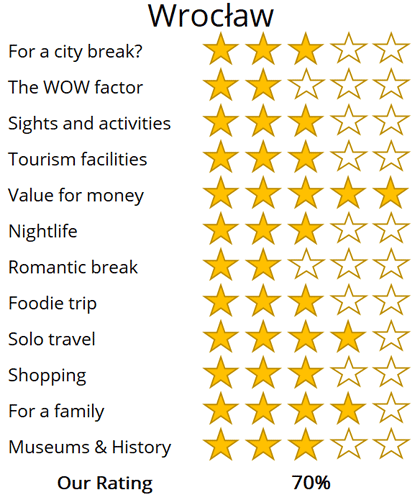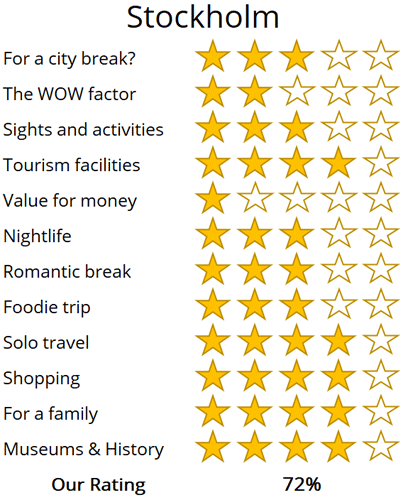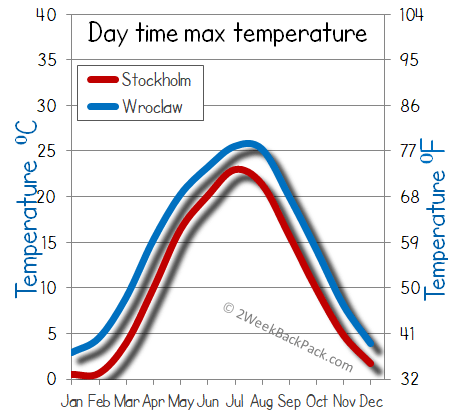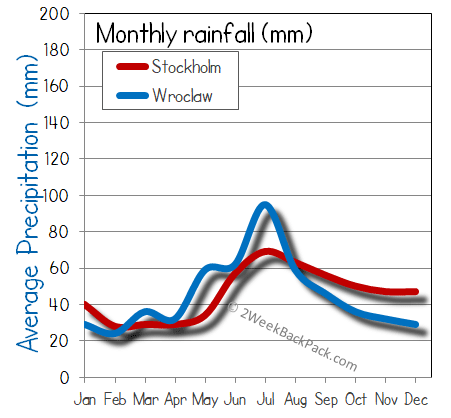WhereToGoForMyHoliday.com
The best destination comparison site!
WhereToGoForMyHoliday.com
The best destination comparison site!
Wroclaw or Stockholm a vs city comparison and travel guide
Wroclaw and Stockholm both offer unique and enticing experiences, but which one should you choose for your city break or holiday?
We understand your dilemma. There is an abundance of travel guides for both cities, but few actually comparing them, and advising you which is the better for your trip.
This article will provide our unbiased and independent views of Stockholm and Wroclaw, hopefully making your choice that little easier.
The article is structured into several sections, each of which can be directly accessed through the following links:
• Introduction to the cities
• Scores and ratings
• Which one should I, friends, or family visit?
• When to visit and weather
• Who is the city suited for?
• The perfect 48hours (with map)
• Tourism details (where to stay? airport details?)
Introduction to Wroclaw and Stockholm
Wroclaw is the historical capital of the Silesia region. It's been ruled and fought over and shaped by countless tribes and peoples, from the warring Slavs of the first millennium to the Habsburg emperors to the Prussian generals of the 1800s.
This makes it a strangely diverse and varied city, with Germanic townhouses and Flemish-styled mansions next to Gothic cathedrals and USSR tenements.
Wroclaw is a good-looking city. It's got a beautiful perch on the Oder River, spreading from island to island with arched bridges that recall Venice and wooded parks aplenty.
The Old Town is the anchor of it all, and a great place to wander, people watch, and drink Polish beers. Beyond come the fairy-tale spires of Cathedral Island, the colossal concrete dome of Centennial Hall (a UNESCO site), and even Zen parks inspired by Japan.
Magical, mystical Stockholm spreads over a speckling of islets surrounded by the icy Baltic Sea. At its centre is the fairy-tale Gamla Stan. Cobbled lanes wiggle and writhe around medieval rowhouses in those parts, opening onto a kitschy plaza filled with gingerbread cafés and grand Neo-Classical palaces.
Next door is happening Södermalm, a lived-in quarter with hipster meatball dives and ethnic eateries. Then there are Norrmalm and Östermalm, where amazing museums meet shopping strips and food halls.
Reputation has it that Stockholm isn't cheap. And it's true, this Scandi capital will set you back a bunch. But try not to let that put you off. There are rewards for loosening the purse strings, from days of fika (cosy coffee breaks) to encounters with ABBA the band to experiencing the buzz of a city that's at once modern and historic.

The historic centre of Wrocław and the Odra River

Stockholm lies on an Archipelago of islands between Lake Mälaren and the Baltic Sea
Wroclaw vs Stockholm: City Ratings
Summary
Where would I journey for a personal escape?
Wroclaw
Where would I send my parents for a memorable visit?
Stockholm
Where's the ideal destination for my adventurous 19-year-old cousin?
Wroclaw
Where should my food-obsessed friend indulge their culinary passions?
Stockholm
Note: The above comparisons are weather-independent and are based on travel during the most opportune times of the year. Details about the ideal travel seasons are elaborated upon later in this article.
In the sections that follow, you'll find a comprehensive comparison between these two fascinating cities. This includes recommendations on the duration of stay, the best times to visit, and tailored 48-hour itineraries for each city.
The final segment delves into practicalities for your travels, such as the best airport to fly into, the optimal districts for your accommodation, and insider tips, for when you come to explore the city.
We hope that you find all of this information useful, in planning your next exciting trip!
Destination details
How long to spend each city?
Stockholm is a perfect city break spot. Two or three days is a great amount of time to while away between the historic Gamla Stan and the museums of Östermalm. What's more, planning a fly-in, fly-out jaunt has never been easier. There are no fewer than four airports serving the town, from big Stockholm-Arlanda to low-cost favourite Skavsta Airport. The advantage? It should be a cinch to find affordable connections in and out, say 72 hours apart.
If you've got a little more time to spare, then use it. Stockholm has secrets that aren't on the main tourist menu. For example, you could venture out to the rugged islands of the outer Stockholm Archipelago. They're for sailing, swimming, fishing, and wandering quaint villages. There are also the Viking relics of Birka and the idyllic forests and lake lands of Bornsjön. All those will require more than just a weekend.
Wroclaw may not be vast in size, but it stands as one of Poland's prominent cities. Its Old Town, brimming with charm, is perfectly navigable on foot, while an efficient tram network offers a swift tour of the key attractions for a modest sum. Generally, a day or two suffices to experience the city’s highlights, making Wroclaw an ideal destination for a brief, fly-in, fly-out weekend retreat.
For those contemplating a more extended stay in Wroclaw, consider interspersing your visit with day trips to the surrounding areas. Nearby, you can explore the forested slopes of Karpacz, visit the awe-inspiring castles along the Eagles Nest Trail, or make a pilgrimage to the sacred site of Jasna Góra.

The waterfront of the Sodermalm district in Stockholm

There are over 350 charming dwarf statues are scattered throughout Wroclaw’s historic centre. These characterful figures even have their own tourist map, along with s tory behind each one….
Unless you're a fan of air pollution and sub-zero temperatures, Wroclaw is not the place to be in the winter. The whole of south Poland gets cold between November and March – really cold. We're talking minus 10 degrees regularly, with sudden snowfalls and freeing rain. Of course, when there is a dusting of the white stuff, the Old Town of Wroclaw can look wonderful, but recent winters haven't been so promising.
For sightseeing and enjoying the student buzz of the town, it's probably better to hold off until May. That's when the weather really starts getting good. You might have chilly evenings, but you should be able to don the shorts and t-shirts for your wanders through the city. What's more, the local university is in session, so the bars will be lively and vibrant.
Summer sees the students go home and the tourists arrive. It's a reliable period for weather, even if you have to deal with the occasional thunderstorm around early afternoon. September is just as nice, if not even better. That's when the trees of the island parks in Wroclaw start to change to yellow and ochre, lending a romantic atmosphere to the Silesian capital.
Wrap up warm if you're heading north in the winter months. Stockholm is a cold capital, but it comes with hefty sides of festive charm. At Christmas, you'll find lovely markets on Stortorget square in the middle of the Gamla Stan, the scents of mulled wine and hot chocolate floating up through the pastel-painted guild mansions. On the flip side, November to March also means uber-short days (think sunset as early as 3pm!) and lots of rain and snowfall.
If you prefer a dose of Vitamin D, consider the white nights of summer. It doesn't get dark until well into the evening between June and August. What's more, the weather is usually warm and mild, with daily averages in the low 20s. Of course, this is also the most popular time to come, so expect hotel rates to be inflated.
If you're a fan of culture-brimming capitals and enchanting old towns, then Stockholm is sure to impress. Whole days of wandering between waterside parks, centuries-old terraces, cobbled squares and stooped taverns are on the menu. And so are visits to places like the Vasa Museum, with its 17th-century Swedish warship pulled up from the deep.
In addition to all that, districts like Södermalm are there to entertain the foodie and the art lover. It's a vibrant mix of multicultural cafés and restaurants. On one corner you'll see a Bahian curry stall, on the next you'll catch a Lebanese rice kitchen. And that's not even mentioning the wealth of fair-trade coffee shops and roasteries that make an appearance.
It's also quite pricy, so we'd recommend anyone on a budget to steer well clear.
If you're the sort of traveller that loves to find off-the-beaten-track cities that don't necessarily have big-name sights, then Wroclaw is sure to be right up your alley. It's not as well known as other towns in Poland but comes with local vibes and interesting neighborhoods. It's also a student city, which means the nightlife can get pumping during term times (September to December and January to June).
Wroclaw has something for those who like the great outdoors, too. Not only is it a green place with lots of parks and riverside areas to explore, but the mountains of the Karpacz and the Czech borderlands are only a short drive to the south. They've got hiking, skiing, spa towns and more.

The twin spires of Wroclaw Cathedral

The Royal palace in Stockholm
48hours in Stockholm
Let's get stuck into Stockholm with this curated 48-hour itinerary. It whisks you from the aged heart of the town to some of its lived-in outer areas, and passes acclaimed museums and eateries as it goes…
Day 1: Hop out at Gamla Stan station in the early morning. Doing that puts you right at the meeting point of the Free Walking Tour Stockholm. Their trips typically take around two hours from start to finish, but they're a fine intro to all the secrets and monuments of the amazing district.
You'll probably encounter the bustling shopping thoroughfare of Stora Nygatan, the narrow alley of Prästgatan, and the handsome Stortorget square, all topped off with the stunning Royal Palace of Stockholm to learn about the boundary-breaking monarchy of Sweden. Once it's finished, be sure to stroll down cobbled Österlånggatan between the toyshops and Nordic taverns.
Have something to eat there and then move south across the water to Södermalm. One of the first things you'll encounter is the Katarina Elevator, with its high lookout points gazing across the old town. A few blocks to the south and you'll be in SoFo. This is the hipster hub of the city. If you can get a place, be sure to dine at quirky Meatballs for the People – expect modern twists on Scandi staples. If not, there are oodles of ramen places and Indian joints to boot.

Stockholm 5
Day 2: Breakfast at the Hötorgshallen. A colossal, two-floor food court, it's bursting with pretzels, smoked-salmon outlets, New Yorker delis, and more. It's also on the edge of Norrmalm's chic shopping area. Wander that to see designer outlets galore before emerging onto the salt-washed quays around Berzelii Park.
From there, you'll be able to see the forested island of Djurgården – your next destination. It's a short walk, with a few riverside cafes like the Sjöcafeet to enjoy en route. Then you delve straight into the Vasa Museum. Simply not to be missed, it's a chart-topper of Stockholm. The whole exhibit revolves around a mighty warship that sunk in Stockholm harbour just minutes after launching in the 17th century.
If time allows, ABBA the Museum is also next door, complete with glitzy pop paraphernalia and the piano on which some of the band's hit tracks were written. Behind all that is the vast open-air museum come park of Skansen. It's got living history that'll transport you back to medieval Sweden, along with a fun funicular train ride and even enclosures with brown bears.

The colourful house on the Stortorget, the main Square of Stockholm
48hours in Wroclaw
Two days is all that's needed to explore Wroclaw from top to bottom. Most of your time will be spent in the charming Old Town area, but a few jaunts to parklands and other districts can combine with lively nights on the beer to boot…
The interactive map below shows a suggested route for the 48 hours in Wroclaw, with day 1 highlighted in green and day two in yellow.
Day 1: Every history lover, people watcher, foodie and sightseer will want to see the Stare Miasto district. That's the Wroclaw Old Town; the piece de resistance of this southern city. It begins around the wide boulevard of Piłsudskiego, passing through a few blocks of Soviet-era tenements before hitting the historic area proper. That starts in earnest by the Fosa Miejska, a centuries-old moat that was part of the town's medieval fortifications until it was destroyed by Jérôme Bonaparte, the brother of Napoleon.
On the left as you make for the heart of the quarter is the elegant Wrocław Opera House, while the leafy walks of Park Staromiejski are the perfect place to go for a picnic in the summer. Keep going north and you'll eventually arrive at the Rynek. This is the beating kernel of the Old Town, where you'll find the most amazing sights of all.
The Gothic-styled Old City Hall draws the eye first, followed by the German-built housing blocks of 1931 – considered by the locals to be among the ugliest in town! Be sure to check out the narrow alleys that weave through the middle of the square at the Sukiennice. Also keep the eyes peeled for the little dwarf statues that dot the plaza. They're a kitschy addition to the cityscape that you'll find on many random street corners.
As the afternoon turns into evening, consider settling in for a beer tasting at the hearty Spiż microbrewery. Or, head for Setka, where Communist paraphernalia adorns the walls and you can sample potent vodka with pickled herring.

The Most Tumski Bridge, where romantics leave love locks attached to the rails and throw the key in to the Odra River. To the rear is the spire of the Bartholomew’s church and the twin spires of the cathedral
Day 2: Having explored the Old Town, our second day begins with an exploration of the surrounding islands on the Oder River. There is a plethora to see, but the highlight is undoubtedly the iconic Ostrów Tumski.
Crossing the picturesque bridges to reach it, you will find yourself in the oldest part of Wroclaw.
The Wrocław Cathedral, with its towering twin spires, dominates the skyline, marking the most majestic church in the city. Inside, you can admire the exquisite stained-glass windows and the soaring vaulted apses.
From there, proceed to Słodowa Island, particularly delightful in the summer months when people gather by the riverside with their BBQ grills. Another worthwhile stop is Wyspa Piasek, renowned for its attractive chain bridges and quaint cobbled streets.
In the afternoon, take tram numbers 2, 4, or 10 from the Old Town to Centennial Hall, a magnificent UNESCO World Heritage Site celebrated for its revolutionary concrete architecture and a dome reminiscent of Rome's Parthenon.
Adjacent to it are beautiful gardens, with the serene Ogród Japoński as the highlight – an ideal spot for contemplation and reflection on Wroclaw's rich history.

The Centennial Hall may cause divisive opinions, but it was one of the first large reinforced concrete structures that ushered in the era of Modernism.
Stockholm has four individual airports. Stockholm-Arlanda is the largest. That's where you're likely to land on long-haul connections. The direct Flygbussarna transfer can get you back and forth in just 45 minutes, but there's also express rail straight to the terminal.
Skavsta Airport is a hub for low-cost carriers like Ryanair and is linked to the city by private coach transfers (travel time: 1.2 hours). Bromma Airport is mainly for domestic links and also has buses straight to the city. Finally, there's Västerås Airport. Over 60 miles to the west, it's popular for Sweden-UK flights. A coach transfer there takes around 80 minutes in total.
If you're struggling on deciding where to stay in Stockholm, look no further than the northern quarters of Södermalm. That's a good balance between affordability, convenience, and proximity to the Gamla Stan. Of course, there are also hotels in the middle of the old town, but you'll usually need to fork out more for the immersion.
Related articles: Where to stay in Stockholm
By far the best way to navigate is on the Storstockholms Lokaltrafik network. The metro is very efficient and clean, running regularly from stop to stop. Get yourself a combined SL Travel Card that allows for unlimited travel for the duration of your trip. These cost around 240 SEK ($25) for three days but will certainly save you money in the long run.

The Royal crown of Sweden and the Royal Palace to the rear
Stockholm is one of the safest capital cities in Europe, though problems are not unheard of. There are still pickpockets and muggings but stay sensible and calm and they are very unlikely to affect your trip. The most common places to fall victim to these sorts of crimes are on the subway, in the Gamla Stan, and in busy food halls..
Never stand on the cycle lane in Stockholm. Getting around on two wheels is an important mode of commuting for many locals. They don't take kindly to folk who get in their way!
The ever-expanding Wrocław–Copernicus Airport is now served by loads of routes coming from across Poland and Europe. It's even possible to arrive on long-haul connecting flights thanks to Poland's flag-carrying LOT airline. There's a bus that leaves the terminals for the centre of town every 20 minutes throughout the day. Tickets cost 3 PLN and the ride is around half an hour.
You can also arrive from Krakow, Warsaw or Katowice by rail. Wroclaw's train station is considered a work of art in itself, so be sure to check out the yellow-painted façade and its grand crenulations as you leave.
Getting around Wroclaw should be easy. The town centre isn't only walkable but a real pleasure to explore on foot. There are lovely bridges linking the little isles on the Oder River, parks connecting the banks of the old city fortifications, and plenty of pedestrianised areas within the confines of the Old Town.

Many of Wrocław oldest builds, were constructed use red bricks
To get out to the Centennial Hall, Wroclaw Zoo, or other districts, you can make use of the efficient tram network. Buy tickets at the MPK Wroclaw machines at any bus or tram stop and then validate them as you board. Basic fares cost 3 PLN per ride, but you can also score passes for several days using the Urbancard website.
Hotels in Wroclaw are generally all located within the ring road of Piłsudskiego. Roughly speaking, the closer you get to the Rynek square the better the location, though staying right on the main plaza might be noisy at night. There are also some lovely boutique stays and B&Bs to find north of the Oder River.
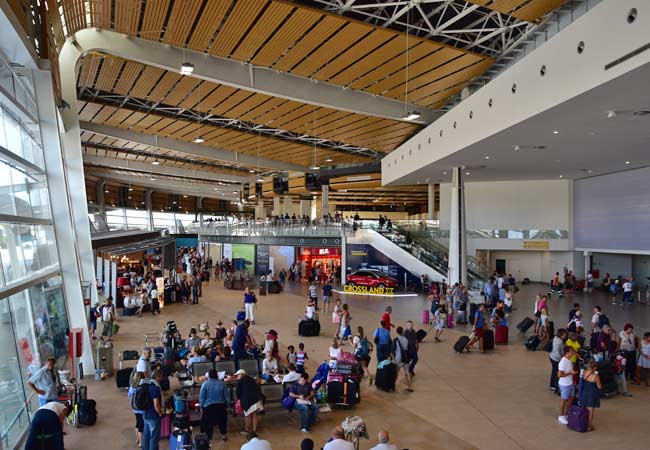
oh we were stuck in the airport!

Copenhagen was a bit expensive...

All we did was drink beer in Brussels...
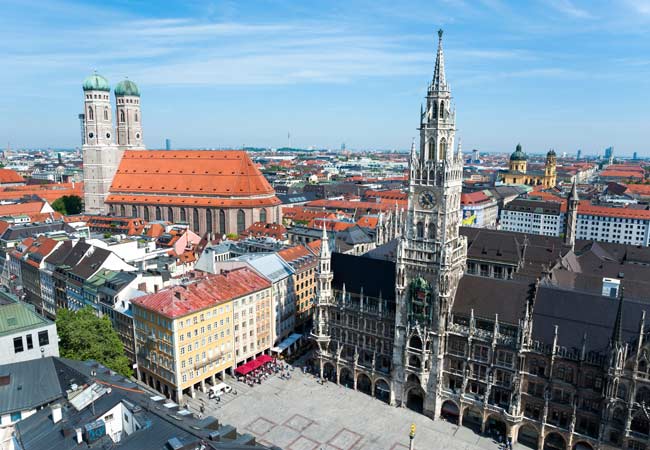
Muncih was crazy
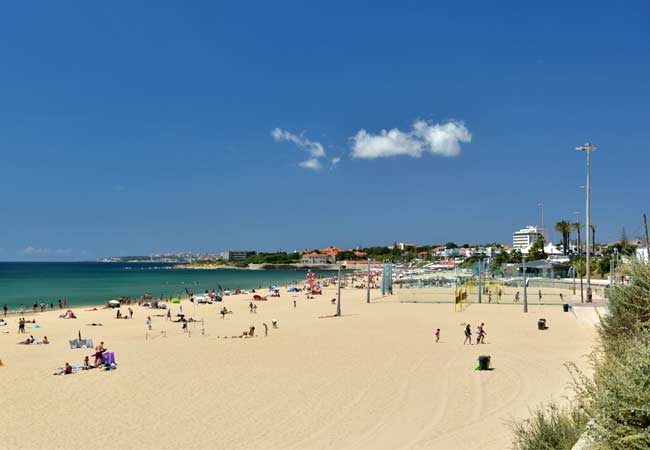
And we got so burnt!
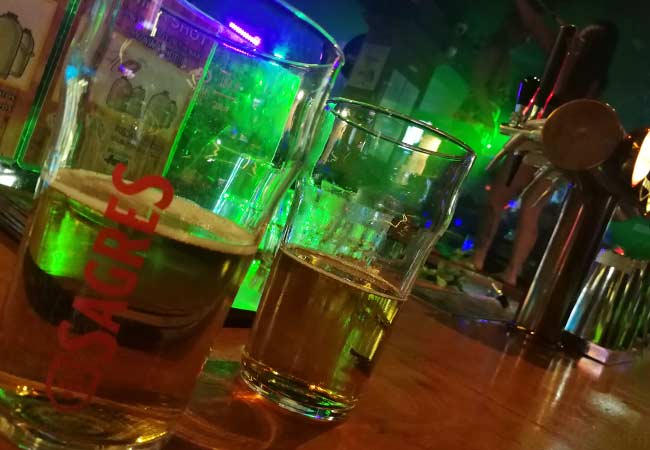
Remeber that night in Rome

oh we were stuck in the airport
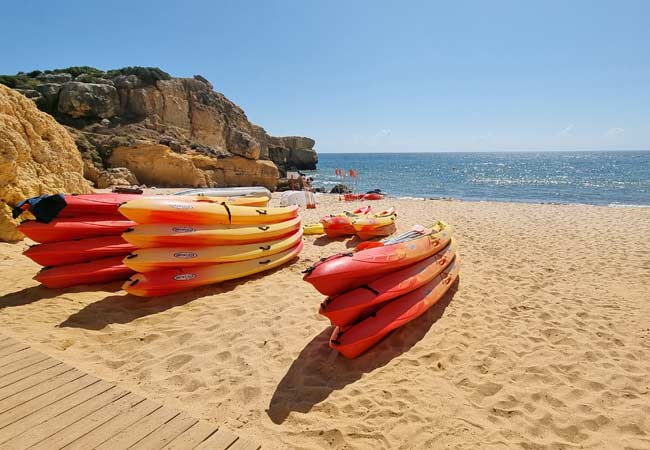
So much fun kayaking

Berlin and that group from Austria!

There was such a view from that church

And we got so burnt!

Munich was eventful, wasn't it!

Such a view from that cathedral in Florence
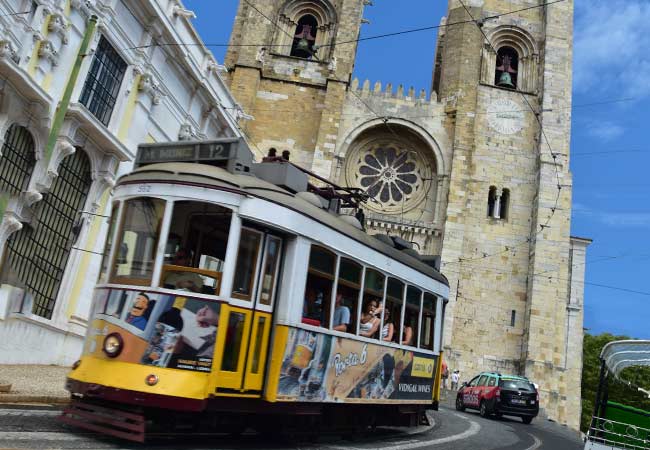
Lisbon was such so much fun

Last summer was so much fun .... x

Remeber that night in Rome

Lisbon was such so much fun

Such a view from that cathedral in Florence

Munich was eventful, wasn't it!

And we got so burnt!

Remeber that night in Rome

All we did was drink beer in Brussels...

Berlin and that group from Austria!

Can't wait to go back to Dubrovnik

Remember that boat ride in Prague

Copenhagen was a bit expensive...
